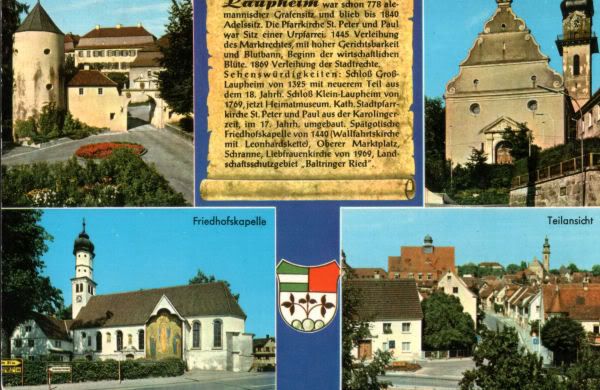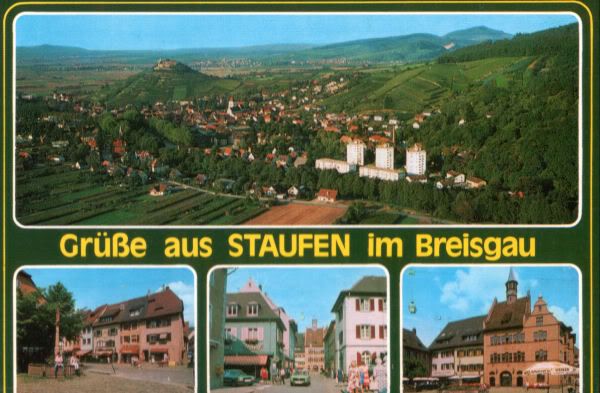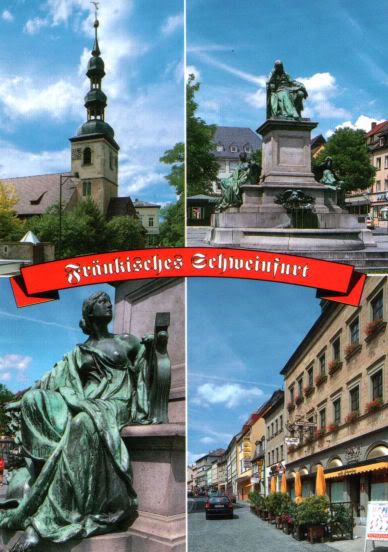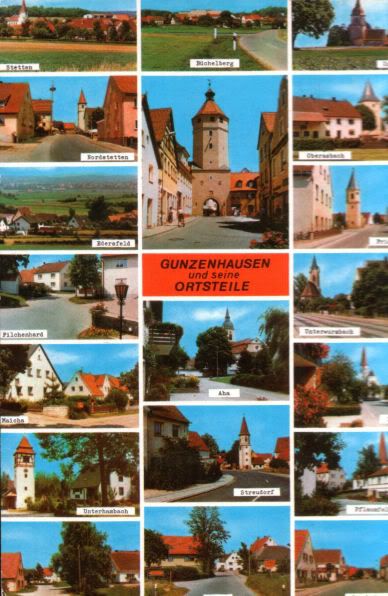Pictures: Postcards
Some more of the postcards I began to post some time ago:
Laupheim is a city in Germany in the state of Baden-Württemberg. The river Rottum runs through Laupheim. The area in and around Laupheim has been settled from very early times onwards. Archaeological evidence shows that 15000 years ago nomadic tribes roamed the countryside. From ca. 2000 BCE onwards, Celts inhabited this area. Castle Schloss Großlaupheim is situated on a hill on the verge of the city close to the local parish church. The existence of a castle in Laupheim was documented for the first time around the year 1100.

Staufen im Breisgau has a population of approximately 7750. Staufen lies at the foot of the Black Forest at the exit from the Münstertal. Staufen lies on the border between two natural and economic areas: the Rhine plain up to the piedmont with its cultivation of grain, winegrapes and vegetables; and the Black Forest, with its cattle and forestries, and, in an earlier time, mining.

Schweinfurt (German for Swine ford) is a city in the Lower Franconia region of Bavaria in Germany on the right bank of the canalized Main, which is here spanned by several bridges, 27 km northeast of Würzburg. The city is first documented in the year 792, though as early as 740 a settlement called Villa Suinfurde is mentioned.

Gunzenhausen is a town in the Weißenburg-Gunzenhausen district, in Bavaria, Germany. It is situated on the river Altmühl, 19 km northwest of Weißenburg in Bayern, and 45 km southwest of Nuremberg. It's twin town is Frankenmuth, Michigan, USA.

Munich (German: München), is the capital of the German state of Bavaria and a Gamma World City. There are, in fact, three locations in Bavaria known as "München" - the one referred to as "Munich", one northeast of Nuremberg, and one north of Passau. Munich is located on the River Isar north of the Bavarian Alps. Munich is Germany's third largest city after Berlin and Hamburg. The city has a population of 1.35 million and the Munich Metropolitan Region is home to around 6 million people. The city's motto was "Die Weltstadt mit Herz" ("The world city with heart") from 1972 to 2005, when it was replaced by "München mag dich" ("Munich likes you"). Its native name, München, stems from an Old German word predating the word Mönche of today's High German, meaning "Monks". Therefore, the figure on the city's coat-of-arms is a monk, and is referred to as the Münchner Kindl, the "child of Munich". Black and gold - the colors of the Holy Roman Empire - have been the city's official colors since the time of Ludwig the Bavarian.

Laupheim is a city in Germany in the state of Baden-Württemberg. The river Rottum runs through Laupheim. The area in and around Laupheim has been settled from very early times onwards. Archaeological evidence shows that 15000 years ago nomadic tribes roamed the countryside. From ca. 2000 BCE onwards, Celts inhabited this area. Castle Schloss Großlaupheim is situated on a hill on the verge of the city close to the local parish church. The existence of a castle in Laupheim was documented for the first time around the year 1100.

Staufen im Breisgau has a population of approximately 7750. Staufen lies at the foot of the Black Forest at the exit from the Münstertal. Staufen lies on the border between two natural and economic areas: the Rhine plain up to the piedmont with its cultivation of grain, winegrapes and vegetables; and the Black Forest, with its cattle and forestries, and, in an earlier time, mining.

Schweinfurt (German for Swine ford) is a city in the Lower Franconia region of Bavaria in Germany on the right bank of the canalized Main, which is here spanned by several bridges, 27 km northeast of Würzburg. The city is first documented in the year 792, though as early as 740 a settlement called Villa Suinfurde is mentioned.

Gunzenhausen is a town in the Weißenburg-Gunzenhausen district, in Bavaria, Germany. It is situated on the river Altmühl, 19 km northwest of Weißenburg in Bayern, and 45 km southwest of Nuremberg. It's twin town is Frankenmuth, Michigan, USA.

Munich (German: München), is the capital of the German state of Bavaria and a Gamma World City. There are, in fact, three locations in Bavaria known as "München" - the one referred to as "Munich", one northeast of Nuremberg, and one north of Passau. Munich is located on the River Isar north of the Bavarian Alps. Munich is Germany's third largest city after Berlin and Hamburg. The city has a population of 1.35 million and the Munich Metropolitan Region is home to around 6 million people. The city's motto was "Die Weltstadt mit Herz" ("The world city with heart") from 1972 to 2005, when it was replaced by "München mag dich" ("Munich likes you"). Its native name, München, stems from an Old German word predating the word Mönche of today's High German, meaning "Monks". Therefore, the figure on the city's coat-of-arms is a monk, and is referred to as the Münchner Kindl, the "child of Munich". Black and gold - the colors of the Holy Roman Empire - have been the city's official colors since the time of Ludwig the Bavarian.
